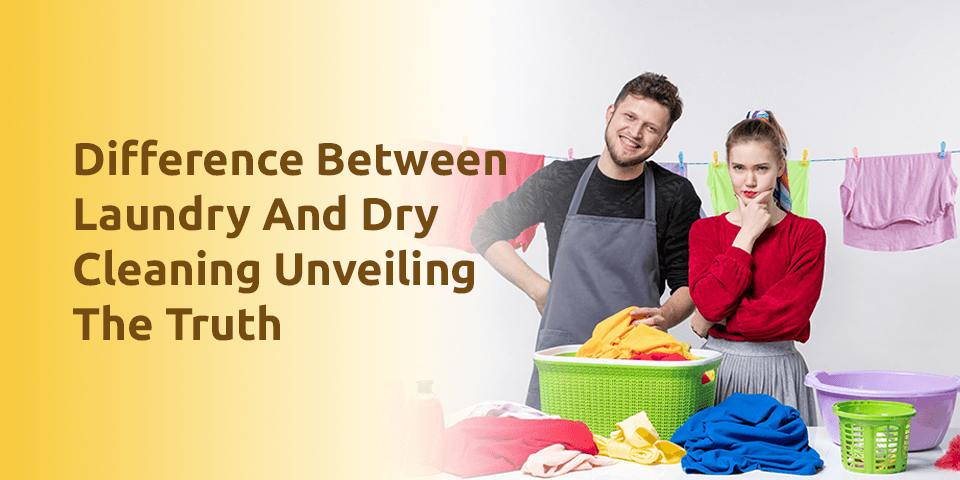Difference Between Laundry And Dry Cleaning: Unveiling The Truth

10 Ways To Remove Yellow Stains From White Clothes
April 15, 2024
Tips For Quick Dry And Smell-Free Clothes In The Rainy Season
May 30, 2024The clothes we wear influence how we feel about ourselves. People are more confident when they wear good clothes. For good clothes, one must keep them clean and maintain them so they can last long. But often we are confused about whether the clothes need to go to the laundry or for dry cleaning. Both methods are used to clean the clothes but are slightly different in the methods and tools used and for which material what kind of cleaning is required.
Laundry uses a wet cleaning method whereas, for the dry cleaning process, chemicals and solvents are used. Does dry cleaning, clean better than laundry? It is crucial to know the difference between laundry and dry cleaning.
Learn the essential differences now and choose the best care for your garments!
A] Understanding Laundry
Laundry is cleaning and washing clothes using water and detergent. It is the traditional washing method which involves agitation to remove the dirt and stains. You can decide the intensity of the tumbling and rinsing of the clothes in a machine, whether it needs a strong wash or a quick wash depending upon the stains and dirt accumulated. The clothes are soaked in water, washed, rinsed and then air-dried. This can be used for the majority of everyday clothes.
The detergents used can be either in powder, liquid or pod forms. You can wash the clothes at different temperatures as per the requirement of the fabric. It can be done at home or can be professionally cleaned by the launderers. At home either you can hand wash or machine wash the clothes. The laundry method can be used for the majority of fabrics excluding delicate fabrics like crepe, silk, georgette and wool. This is the most affordable method to clean clothes.
B] Exploring Dry Cleaning
Dry cleaning is the process in which the clothes are cleaned using solvents instead of water. This method is used for delicate fabrics or clothes with intricate designs and embellishments which cannot be washed in machines. The dry cleaning process has an upper hand over traditional laundry because it does not use agitation, or does not damage colour, size or material. For dry cleaning, the clothes are separated according to the material, stains, and type of solvents required and then washed. The solvents do not damage the fabric and make the clothes look new and fresh.
C] Key Differences Between Laundry And Dry Cleaning
1. Cleaning Method
Laundry uses water and mild detergent along with agitation to clean clothes. The laundry detergents used can be either in powder form, liquid or pods. Whereas, dry cleaning uses solvents that are harsh on stains and dirt. The solvents used for dry cleaning might be toxic but still, the process is eco-friendly as it does not use water for cleaning.
Laundry uses water, detergent, and agitation to clean clothes, while dry cleaning uses solvents. Agitation used in the laundry method might prove a little harsh on the clothes and cause early wear and tear. Whereas, dry cleaning maintains the size, shape and colour of the fabric.
2. Types of Fabrics
Laundry involves agitation while washing, to remove the dirt and clean the clothes. Thus, sustainable materials like denim, cotton, cotton mixes, nylon, polyester and linen can be machine-washed. Dry cleaning is strong on the stains but mild on the clothes, maintaining its durability and preventing any damage to the fabric. This is the reason, the materials shrink on coming in contact with water or delicate fabrics that cannot withstand the tumbling of laundry are dry cleaned. Materials like silk, crepe, georgette, wool, net, and tissue need dry cleaning.
Laundry is suitable for most machine-washable fabrics, while dry cleaning is recommended for delicate fabrics or those that may shrink or fade when exposed to water.
3. Stain Removal
Laundry uses mild detergent which is effective in removing dirt, dust, and sweat and cleaning everyday clothes. Whereas, dry cleaning can remove stubborn food stains, oil-based stains, grease or ink. The solvents used as stain removers for clothes target stains, loosen them from the fabric and remove them while cleaning. The solvent removes the stain from the clothes but does not damage the fabric.
4. Garment Care
Laundry uses agitation and tumbles the clothes for cleaning. This shortens the lifespan of the clothes as there is increased wear and tear. Delicate fabrics get damaged with the agitation. If you want your clothes to look new for a long, to prevent damage to delicate fabrics and to prevent colour bleeding, dry cleaning is the best option.
Laundry may cause wear and tear on delicate fabrics or structured garments, while dry cleaning is gentler and preserves the shape and texture of clothing.
D] When To Choose Laundry Or Dry Cleaning
Generally, the clothes have a tag that mentions the safest method to use for cleaning. The tag that mentions dry cleaning only, can not be home washed to prevent any damage to the fabric. The fabrics that are delicate or have intricate patterns or fabrics with embroidery or embellishments need dry cleaning to prevent any damage to the fabrics, cut and design. Leather, silk, and clothes with double lining that cannot be washed with water, need dry cleaning. The old stubborn stains need dry cleaning as the oil-based stains cannot be removed with only water and detergent.
The dark-coloured cotton clothes that bleed coloured need to be washed separately or dry cleaned to prevent the colour fading and damage to the fabric. Clothes where interfacing is used like blazers, jackets or fancy shirts to give them shape, cannot be washed at home. Dry cleaning services increase the lifespan of the fabric. It is wise to approach professional cleaning services for the best result and increase the life of the fabric.
Learn the essential differences now and choose the best care for your garments!
Conclusion
It is very easy to distinguish between the methods required to clean the clothes according to the material quality, stains on the fabric, the longevity of the fabric and colour. Traditional laundry washing is best for daily use as it is easy and cost-effective compared to dry cleaning. The water wastage while using machines is more compared to dry cleaning. Thus, dry cleaning being eco friendly can be opted for the expensive and intricate fabrics. Select one of the best dry cleaning services in Mumbai for the satisfying experience of wearing clean clothes.




